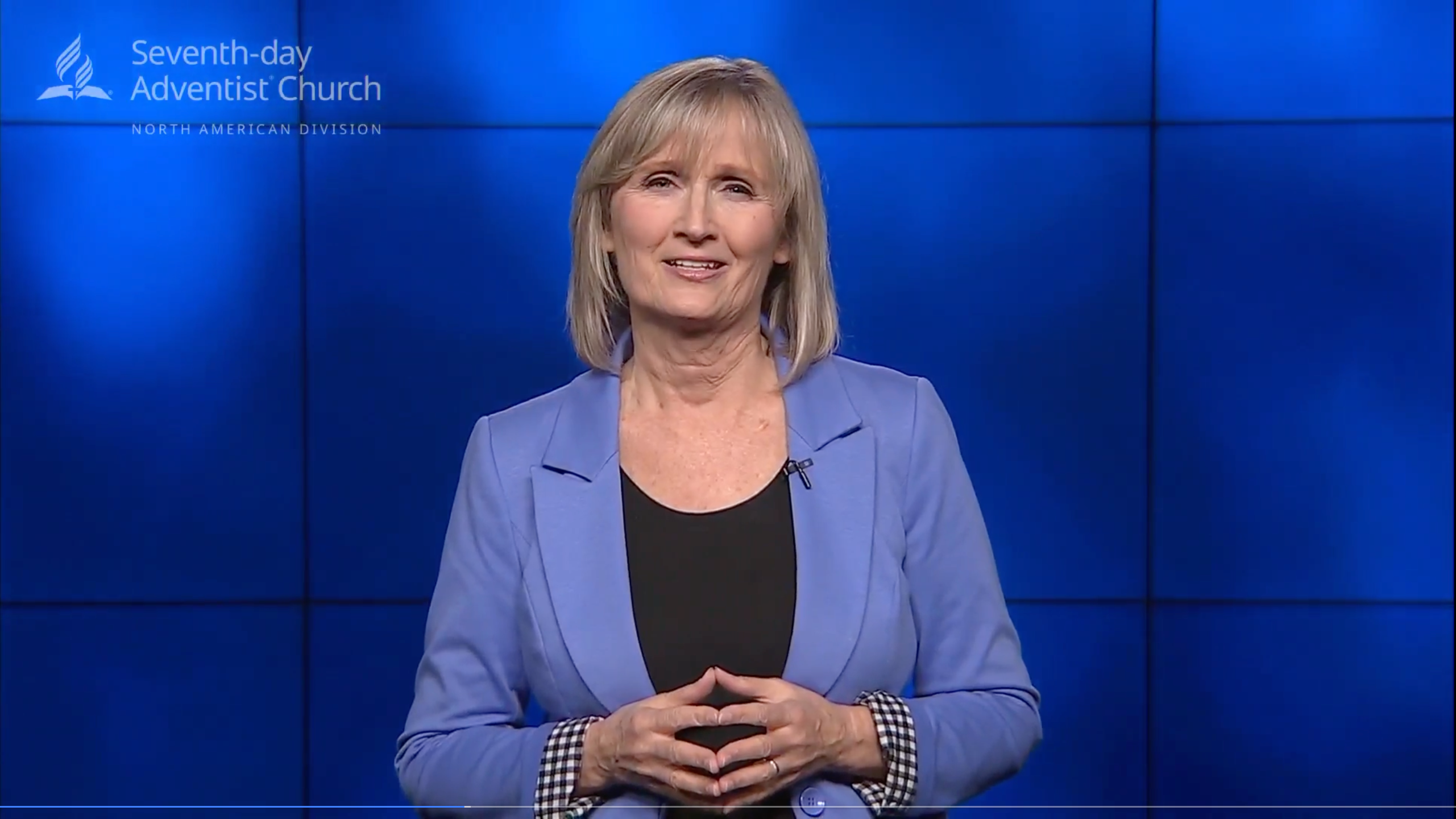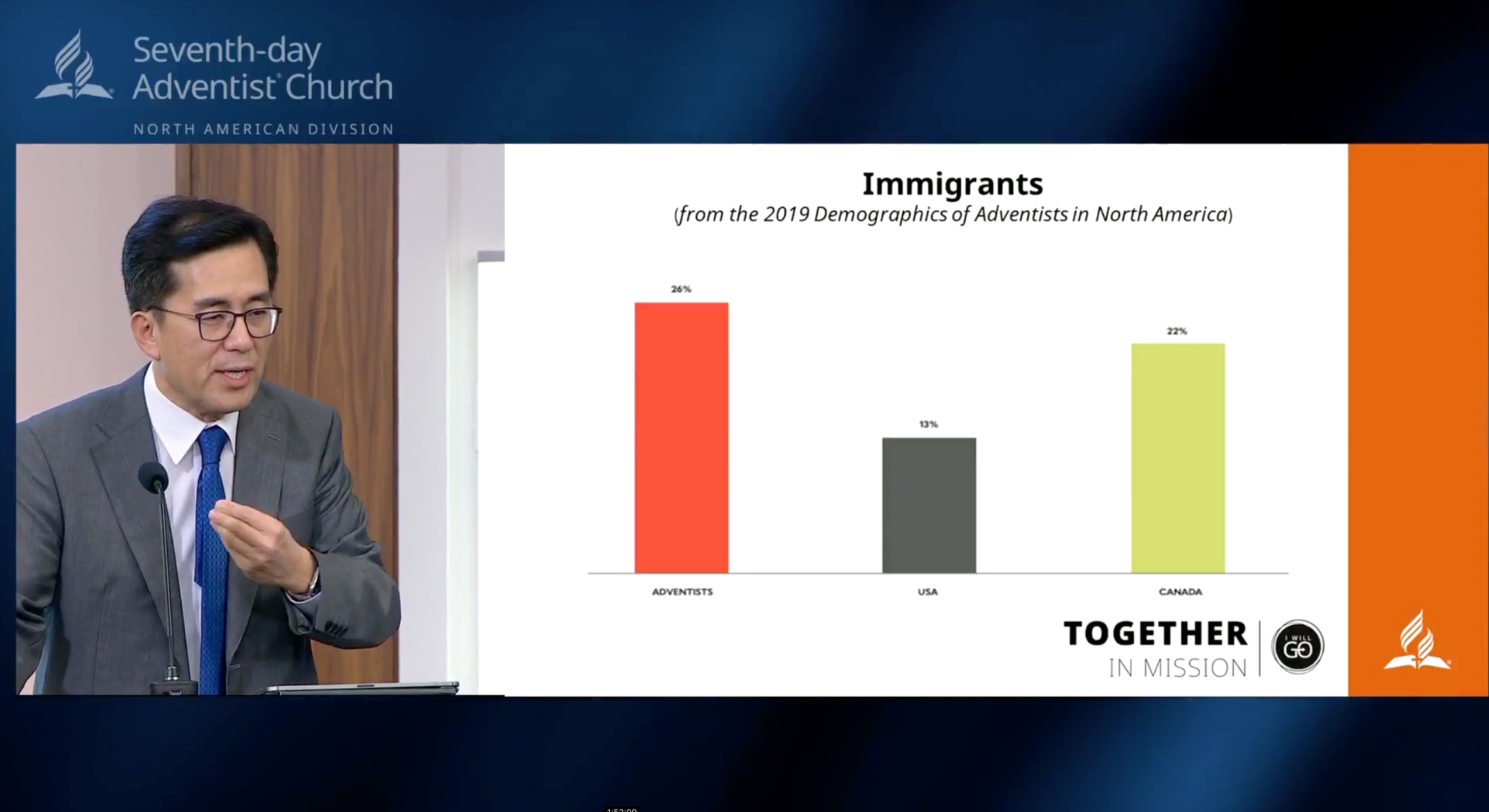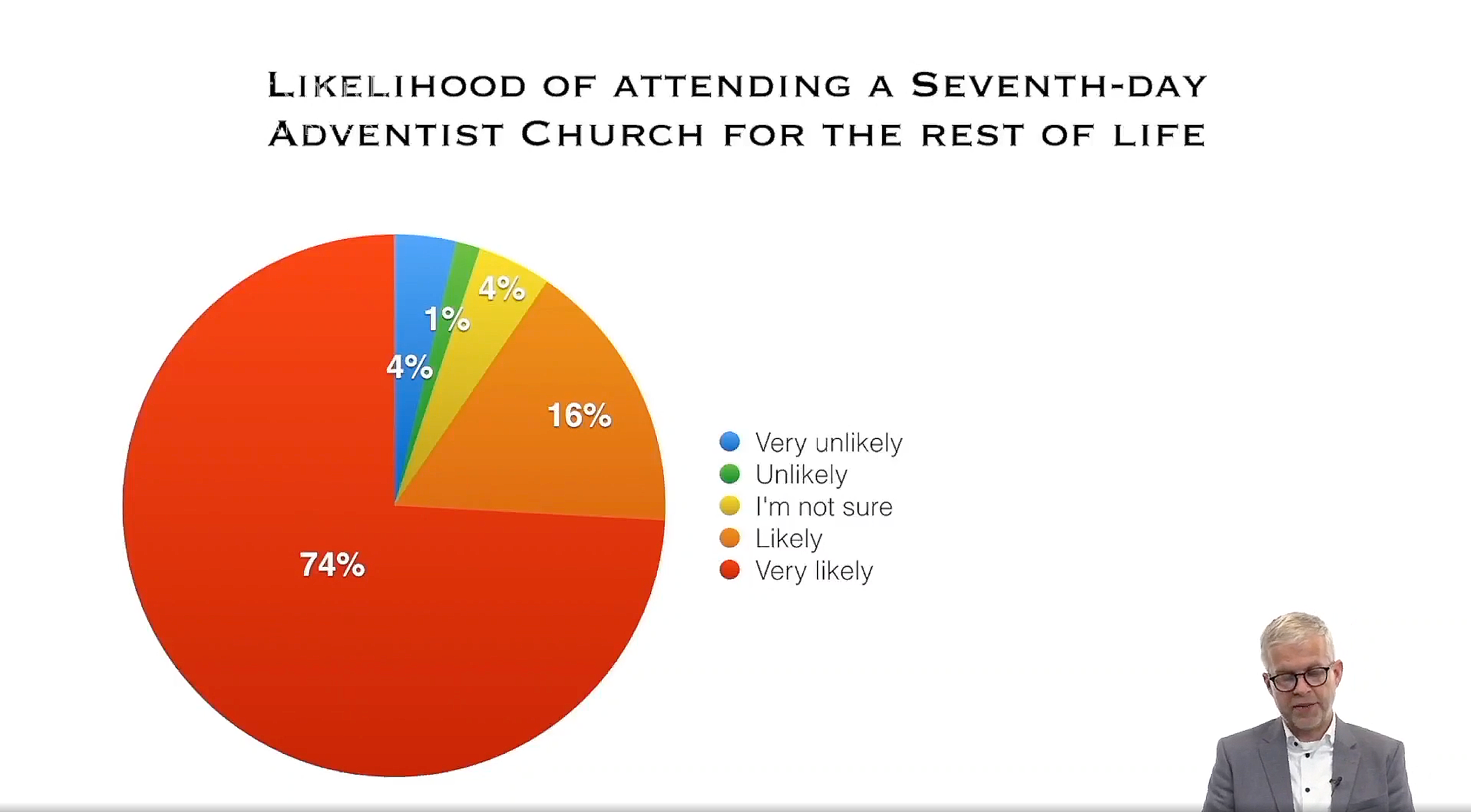
On day four of the North American Division’s 2023 Year-End Meeting, NAD executive secretary Kyoshin Ahn and team delivered an eye-opening secretary’s report. Here, Ahn presents as Judy R. Glass, NAD treasurer, and G. Alexander Bryant, NAD president, look on. Photo: Pieter Damsteegt, NAD.
On October 29, day four of the North American Division’s 2023 Year-End Meeting, NAD president G. Alexander Bryant announced, “This morning, we will have our secretaries’ report. Our secretary team is led by [executive secretary] Kyoshin Ahn. He’s been doing an excellent job, and we're looking forward to a very inspiring, educational, and invigorating report.”
“Now, that’s a challenge!” Ahn responded, chuckling, as others joined in the laughter.
Nevertheless, Ahn and team met the challenge with an eye-opening secretary’s report. Their presentations defined the state of the Seventh-day Adventist Church in North America, emphasized secretariat ministries’ disciple-making efforts, and inspired hope for the church’s future.
Net Membership Growth Impacted by Record Updates
After thanking his team, Ahn shared that as of the second quarter of 2023, the NAD had 1,243,206 members worshipping in 5,719 churches and 910 companies.
Ahn noted a significant membership decline in 2022, leading to a net membership change of -37,245. “Let me share the good news — we didn’t lose most of these people,” he reassured delegates. He explained that the losses were due to a systematic,18-year membership audit completed in 2022, which resulted in four conferences removing 52,193 names from their books.
He commended the conferences for taking this step toward statistical integrity. “We [now] have much better membership data than before,” he affirmed.
Ahn highlighted the division’s 23,869 baptisms in 2022. He noted encouraging trends — i.e., baptisms for the first two quarters of 2023 nearly matched the pre-pandemic total, and by the end of 2022, the number of professions of faith “fully rebounded from the pandemic.”
Other Key Membership Statistics
Regarding demographics, 47 percent of NAD members are aged 30-59, with 32 percent over 60. Ages 19-29 represent 15 percent, ages 13-18 five percent, and the 0-12 age category only one percent of members, excluding unbaptized children. The gender breakdown is 53 percent female, 41 percent male, and six percent unstated.
Sadly, in 2022, 9,100 members died, 1,000 fewer than in 2021 but higher than pre-COVID-19 numbers. Ahn projected a return to pre-pandemic levels of 8,000 by December 2023.
Also, in 2022, 9,000 members were missing, and 3,000 were removed from church records. To address this ongoing concern, Ahn introduced a report from Bonita J. Shields, associate secretary, who leads retention and nurture initiatives.
Nurture and Retention within the NAD

Bonita J. Shields, associate secretary, who oversees NAD retention and nurture initiatives, spoke on efforts to retain the tens and thousands of members missing or dropped from church records every year.
Shields first referenced Jesus’s prayer to “keep those whom the Father had given Him” in John 17:11,12. “As spiritual leaders in the Seventh-day Adventist Church, our mission is not only to reach people for God’s kingdom but to keep them as well,” she said.
She then shared the secretariat’s objectives for nurture and retention:
- To train and resource executive secretaries throughout the Division to foster a culture of nurture and retention.
- To align with other church entities in the work of nurture and retention.
To achieve objective No. 1, they are partnering with conference executive secretaries and clerks to expand the role of church clerks in nurturing and retaining members.
For objective No. 2, Shields presented an interconnected, three-part cycle for nurture and retention, encompassing nurture, discipleship, and reclamation.
Finally, Shields recounted that when she was elected NAD Stewardship Ministries director in 2018, the late Daniel R. Jackson, then-NAD president, asked her, “How do you feel?” “Nervous,” was her honest response. She recalled, smiling, “He said, as only Elder Jackson could, ‘Good. If you weren’t nervous, the work’s not big enough.’”
She concluded, “The work of nurture and retention is bigger than all of us. So, we ask your prayers to make Jesus’s prayer a reality and fulfill our sacred trust to keep our members.”
eAdventist Report on Attendance
Brian Ford, eAdventist membership ministry director, highlighted division-wide church attendance trends for the roughly 50 percent of churches tracking attendance. He shared that attendance ratios, representing the percentage of attendees relative to members, had declined in 2020 and 2021 and risen in 2022.
Ford also noted that a mix of church sizes appeared in various attendance ratio ranges, with ratios of 80 percent or above found primarily in church plants and smaller congregations.
“The good news is, in 2023, we’re almost back to pre-COVID levels [in all ranges],” Ford asserted.
Finally, he referred to the North Pacific Union Conference (NPUC), whose rigorous research on pre-pandemic attendance trends helped establish a 40-50 percent ratio benchmark for post-pandemic recovery. “In 2023, more than half our congregations [met or exceeded] that NPUC average,” he remarked, stating, “It seems clear that no matter whether you worship in a house church or a large church, no matter where on the map your church is, your church can thrive.”
Congregational Changes in North America

Research comparing NAD churches to U.S. churches of all denominations show that NAD churches have twice as many immigrants, 26 percent, as the average U.S. church. They also have more immigrants than the populations of the U.S. (13 percent) and Canada (22 percent). “We are a worldwide church whose work began in North America. [Thus], many of our members outside North America are prepared to have an immediate sense of belonging when they step into a congregation here. This is where our growth is happening,” explained Ahn.
Ahn compared the state of our congregations to the broader Christian church in the U.S. using three data sources: 1) the 2020 Hartford Institute’s Faith Communities Today Survey, in which 11,000 U.S. Christian congregations took part; 2) supplementary Adventist data from the same survey[1], including 320 Adventist churches; and 3) eAdventist membership data.
Key comparisons included:
- Congregational size — Seventy percent of U.S. congregations of all denominations have 100 or fewer weekly attendees but account for only 14 percent of all attendees. In contrast, the 77 percent of NAD congregations with 100 or fewer weekly attendees are home to 47 percent of all attendees.
- Congregational growth — While fewer U.S. congregations are growing overall, thirty-four percent of U.S. congregations increased attendance by five percent or more between 2015 and 2020. Twenty-four percent of NAD congregations increased membership by five percent or more during the same period.
- Congregational characteristics — NAD churches have twice as many immigrants, 26 percent, as U.S. churches. They also have more immigrants than the populations of the U.S. (13 percent) and Canada (22 percent). “We are a worldwide church whose work began in North America. [Thus], many of our members outside North America are prepared to have an immediate sense of belonging when they step into a congregation here. This is where our growth is happening,” explained Ahn.
- Pastoral characteristics — The median age for U.S. pastors is 57. Excluding administrators and departmental directors, the average age of NAD clergy is 49. Including administrators and departmental directors, the median age is 58. Ahn also noted that clergy and congregations are aging across denominations.
Office of Volunteer Ministries
During a video report, the NAD Office of Volunteer Missions (OVM) director Ernest Hernandez highlighted a 55 percent increase in local volunteers, with sixty-five percent serving within the division. He emphasized the office’s preparation and sending of volunteers to urban centers of influence and underserved populations, per their strategic focus.
Gladys Guerrero, OVM’s tutoring and mentorship coordinator, introduced a new literacy initiative for at-risk children and encouraged Adventist entities to create more service opportunities in different areas through hesaidgo.net.
Casey Vaughan, OVM recruiting and marketing specialist, shared that OVM tripled its social media following to nearly 9,000, increasing non-Adventist university deployments from 16 to 45. Other new projects include a kids’ mission letter, a children’s coloring book (download here), and a monthly e-magazine for teens.
Hernandez concluded, “Through God’s grace and power, you and your local church members are making [OVM’s growth] possible. Let’s continue to work together in missions. And remember, I will go because He said go.”
Office of Human Relations
Carolyn R. Forrest, associate secretary and Human Relations director, shared her focus on training; diversity, equity, and inclusion; supporting the continued growth of women in pastoral ministry; and “striving to be more like Jesus.” She also assists conference and union leaders with policy matters through training; offers cultural intelligence training at the NAD’s annual human relations advisory; and consults with leaders on secretariat and human relations issues.
Forrest highlighted the value of diversity, equity, and inclusion (DEI) initiatives, including recognizing designated months for various ethnic groups and special days like International Women’s Day. “Be intentional about DEI in your organization. Pray about it, talk about it, plan for it, and work at it,” she advised.
She concluded, “Without our willingness to be led by God, little that is of any good is possible.”
Office of Human Resources
Human resources director Danielle Toddy discussed her team’s work serving NAD administrators and employees. She also emphasized endeavors engaging the broader HR community, such as the quarterly online learning opportunity “Let’s Connect.”
Toddy highlighted the annual NAD HR conference, which provides networking, mentorship, and educational opportunities for HR professionals. “Last year, we hosted our largest conference with more than 300 HR professionals and leaders from [various] denominational entities.”
She concluded, “Our goal is to focus on HR’s role in supporting the ministry and fulfilling the mission of the Seventh-day Adventist Church.”
Office of Archives, Research & Statistics
Michael Campbell, director of the NAD Office of Archives, Statistics, and Research, underscored his department’s efforts “to better understand where we have come from and sharpen our focus into the future.”
Campbell discussed several ventures, such as a research committee tracking division-wide research efforts, support of the Global Survey on Adventist Beliefs, development of resources including a new curriculum on Ellen G. White, and an inaugural conference on women in Adventist history.
This department also prioritized digitizing Adventist records, including launching a mobile digital scanning station, and updating articles in the Encyclopedia of Seventh-day Adventists. “We’re close to having an updated article for every [NAD] conference and union,” he noted.
Campbell’s research covered the NAD’s origins, Adventist oral histories, including with the late Debra Brill, former NAD vice president, and collaborations with the Youth and Pathfinder ministries in preparation for the 2024 International Pathfinder Camporee.[2]
Department of Professional Services
Rohann Wellington, NAD director of professional services, highlighted his department’s critical, cost-effective offerings as an internal creative team. Professional services’ collective of project managers, social media, graphic, web, and multimedia specialists helps NAD administrators and directors journey from “the first spark of an idea to the final product.”
Wellington underscored that as his team has grown, so has the breadth of their services. For instance, they now manage 70 social media profiles and expect to fulfill nearly 900 project requests, double the previous year.
Finally, he emphasized that “professional Services is more than just a support system. We’re partners in the mission consistently striving to illuminate the impactful work of the NAD departments, all to bring souls closer to Christ.”
2023 Global Church Member Survey

The 2023 Global Church Member Survey, presented during Kyoshin Ahn's secretary's report at the NAD Year-End Meeting, revealed that 74 percent of North American respondents were very likely to remain in the Seventh-day Adventist Church for their lifetime.
Petr Činčala, director of the Institute of Church Ministry at Andrews University, gave a final presentation on GC’s 2023 member survey. In 2022, 1,819 NAD members responded, primarily from the U.S. (80 percent) and Canada (nine percent). Interestingly, two-thirds
had been baptized for more than 30 years, and more than a third considered themselves active participants or leaders in the church. Most (40 percent) were 65 and older, with a significant minority (27 percent) between 36-54, and 62 percent were female.
Key findings included:
- Three-quarters attend in-person church services almost every week or more.
- Roughly three-quarters feel cared for by Sabbath School leaders and pastors.
- Two-thirds are satisfied with their local church, and nearly three-quarters are likely to be lifetime church members.
- Nearly three-quarters read the Bible several times a week.
- Most agree with core Adventist beliefs and that the church is God’s true last-day church.
Other, more mixed findings were:
- Thirty-nine percent have been emotionally hurt by church leaders, people, or incidents.
- Forty-one percent believe the Holy Spirit is God’s power in the world, not a person.
- Sixty-one percent embrace the church’s interpretation of end-time prophecies.
- While 88 percent believe Christ’s coming is imminent, only 32 percent believe He will return in their lifetime.
- Eight-five percent agree that Ellen G. White’s writings come from the spiritual gift of prophecy, but fewer (69 percent) fully embrace her as a prophet.
Finally, while more than 80 percent believe in the health message, 20 percent have consumed alcohol, and 38 percent believe they can choose which parts of the health message to follow.
Unity in Diversity
As the secretary’s report ended, Ahn asked, smiling, “What image of our members was emerging in your mind as you listened to this report?” He continued, “I see people coming together from very different backgrounds, cultures, races, ethnicities, generations, and languages, clustering around one common denominator – the Adventist Christian faith. The conviction that Christ purchased the church with His blood and ministers on our behalf [brings] our members and churches together. No human institution, no red book [working policy], no human institution, no agent can do it. This is the doing of God.”
He concluded with a prayer based on Psalm 17:8, “Oh God, keep us as the church as the apple of Your eye. Hide us in the shadow of Your wings.”
Delegates accepted Ahn’s report after an animated 30-minute discussion, including a vote recommending that the GC add a policy to the church manual around transitioning a church to a company or group.
And NAD president G. Alexander Bryant joined the chorus of delegates affirming Ahn’s presentation, stating: “Thank you [for a] thrilling, educational, and inspiring report. We’re one mission, one people, one God.”
[1] Data from the Hartford Institute for Religion Research included only U.S. churches; however, eAdventist data also included Canada.
[2] Follow Instagram.com/nadadventistarchives for more updates.
